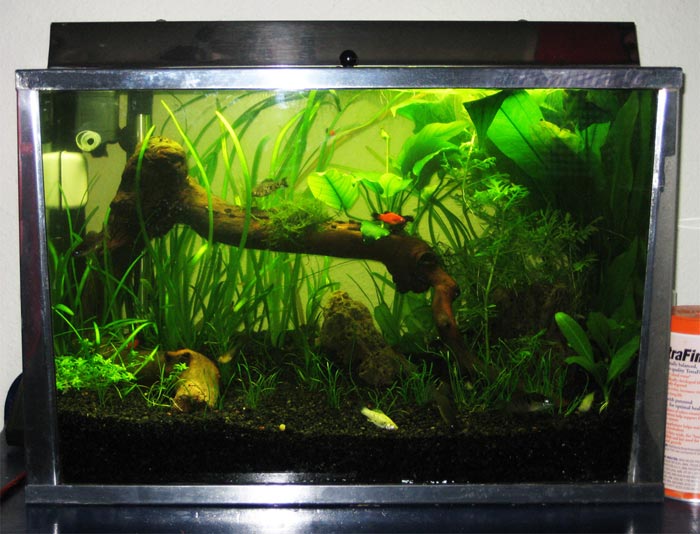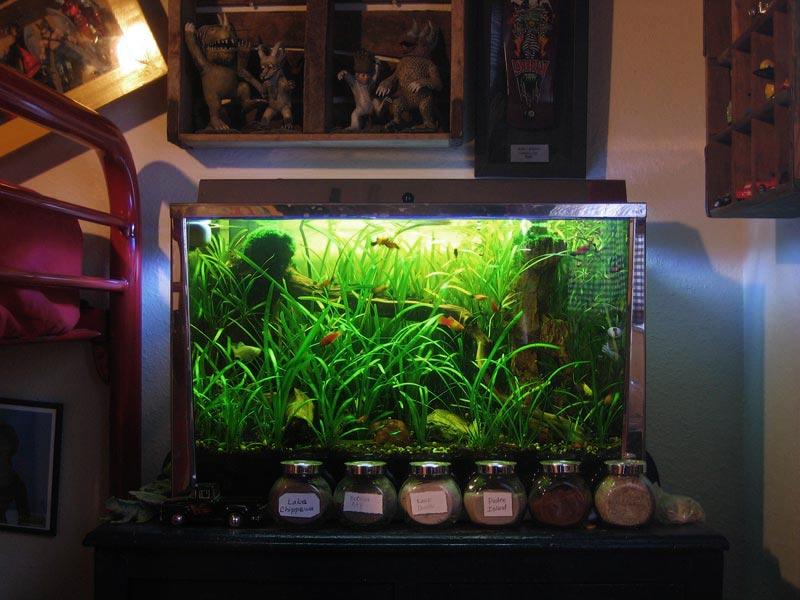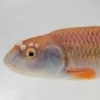ph
#1
 Guest_CaptainCritter_*
Guest_CaptainCritter_*
Posted 08 February 2012 - 08:12 PM
#2
 Guest_Yeahson421_*
Guest_Yeahson421_*
Posted 08 February 2012 - 09:32 PM
#3
 Guest_fundulus_*
Guest_fundulus_*
Posted 08 February 2012 - 10:05 PM
#4
 Guest_EricaWieser_*
Guest_EricaWieser_*
Posted 08 February 2012 - 10:14 PM
Red flag, nitrate should never be at 0 ppm. Even the most heavily planted tank should hover around 10 ppm, otherwise the plants are starving. Ammonia and nitrite at 0 ppm is typical and healthy for a cycled tank, but there is no shame in having a nitrate concentration even as high as 30 ppm. If your test kit honestly did read zero ppm then you can't trust it and might want to buy a new one.Zero ammonia, nitrites, nitrates.
The pH matters when breeding certain species of native fish. For example one Okefenokee swamp species, Leptolucania ommata, won't spawn until the pH drops below 6. So if you're trying to breed native fish then yes, for some species pH might matter.PH isn't much of an issue with natives. Even fish from the incredibly acidic Okefenokee adapt well to more regular PHs.
For a non-breeding community tank like CaptainCritter wants: yes, in general darters, madtoms, and shiners do well at your pH of 6.8 or 7.2. That is actually dead average, neither acidic nor basic. There is no reason to change or attempt to modify your pH at all, CaptainCritter. The peat moss is unnecessary for your fish species.
Just remember to drip acclimate whenever you're moving fish from one water to another, and you'll be fine.
Here's a video to demonstrate the technique:
If you drip acclimate them, most fish make it even if the pH, DH, and temperature are very different from what they came from. The downside is that drip acclimation takes hours and hours. But it's worth it because the fish survive.
Once, back when my water was hard and alkaline, I bought 20 neon tetras from a pet store, tossed them in my tank, and every single one was dead by the end of the day. A year later I tried it again and drip acclimated them for five hours. I didn't lose a single one. Drip acclimation can really overcome pH differences so that they don't shock the fish. *nods*
Edited by EricaWieser, 08 February 2012 - 10:26 PM.
#5
 Guest_ashtonmj_*
Guest_ashtonmj_*
Posted 09 February 2012 - 07:23 AM
#6
 Guest_gerald_*
Guest_gerald_*
Posted 09 February 2012 - 11:02 AM
Regarding Matt's no-water-change strategy, sometimes that works especially if the same fish have lived together for years and you rarely add new fish. But IME, in general, fish are more likely to get sick if you never change water, and new wild-caught shiners and darters placed in old dirty water might not acclimate well. Redbelly dace and Percina and Nothonotus darters in particular seem prone to getting emaciated and lose vigor in old water with high nitrate and other waste build-up.
#7
 Guest_Markart_*
Guest_Markart_*
Posted 09 February 2012 - 01:20 PM
I've read of no water change policies for certain planted tanks, but would never consider this approach in 99.9% of aquaria. For me water changes are a must for any fish.
#8
 Guest_CaptainCritter_*
Guest_CaptainCritter_*
Posted 09 February 2012 - 08:30 PM
#9
 Guest_rickwrench_*
Guest_rickwrench_*
Posted 10 February 2012 - 05:24 AM
Back when I believed in test kits, I had a few very heavily planted, soft water tanks (not CO2 enriched) that would test pretty low (6.0 - 6.2) in the mornings due to nighttime plant O2 respiration. But by evening, ph would have crept back up into the mid 7's as the CO2 (carbonic acid) was all used up by the plants. With minimal buffering, the diurnal CO2 swing can really move the ph up and down. The fish in those aquariums thrived for several years.My tap water has very low buffering and pH can plunge into the 4's if I'm not careful.
Ph itself is rarely the fish killer, rather the sudden changes in general and carbonate hardness (aka, conductivity) are the root cause of the stress/shock when transporting fish home. This is why the "drip method" for acclimatizing fish works. Not because the ph levels are slowly reaching an equilibrium, but because the water's hardness is.
A ph test doesn't really tell you much of anything, by itself. The relationship between hardness and CO2 is what controls ph. Say your tank's ph is 7.0. Great, what does that mean? If your KH is 10, it means your fish are on the verge of suffocating, if your KH is 2, your tank's plants have used up most of the available CO2, and the water is probably O2 saturated.
In a healthy planted tank, soft or not, sudden downward ph swings are caused by a big boost of CO2 from somewhere, usually decaying matter, like a hidden dead fish.
400+ gallons of captive water in many tanks here, and no water changes in years.I've read of no water change policies for certain planted tanks, but would never consider this approach in 99.9% of aquaria. For me water changes are a must for any fish.
It depends on how committed you are to creating a truly balanced aquarium (not a "fishtank"). High plant mass and a live, healthy substrate (dirt, or capped dirt), will happily consume all waste produced by a modest amount of critter life. Also, they will absorb and lock up all of the inevitable build up of chemicals and metals from evaporated water replacement. Over the course of a heavily planted tank's life, you remove the same impurities that multiple water changes would have removed as you trim/prune the plants, which have been busy doing their job growing, filtering and consuming NO3/4, sequestering other contaminants. They do such a good job, that eventually (couple/3/4 years) they will burn through all nutrients available in the tank's substrate, despite the supplemental plant nutrient supplied via fish waste, and you will notice some of the plant species in the tank will "stall", for lack of a better word. Time to rebuild.
Heavily planted, means just that, too. Not three sprigs of elodia, 4" of anubias rhizome, and a 2" potted sword.
My BBS aquarium.
My Bluespotted sunfish aquarium.
As the years go by, the water will become progressively softer. The softer the water, the bigger the potential daily ph swings from plant CO2 production/absorbtion, just like a pond. Some plants are better than others at filtering. Vals seem to remove carbonates faster than most other plant I've kept. Egeria densa also is a carbonate gobbler. Water lettuce sucks up metals so well it can starve your other plants of required trace metals.
The CO2 produced by fish respiration is negligible in the kh/ph/CO2 equation, btw.
Many years ago, I boxed up all my test kits, sold my CO2 enrichment equipment, and decided to let the plants, fish, snails, etc., tell me what's going on in the aquarium. Much more rewarding to me to trim once every month or so, and do nothing else but feed the fish and enjoy the tanks.
Rick
Edited by rickwrench, 10 February 2012 - 05:28 AM.
#10

Posted 10 February 2012 - 09:16 AM
You're my hero... and I do not want to derail this, but just to clarify and put some specific numbers to your definition of balanced... how many Enneacanthus sunfish do you have in each of those aquaria and how large are they?It depends on how committed you are to creating a truly balanced aquarium (not a "fishtank"). High plant mass and a live, healthy substrate (dirt, or capped dirt), will happily consume all waste produced by a modest amount of critter life.
I have a no filter, no algae, do nothing 25 gallon with lots of plants and only one Enneacanthus that is aligned with your above statements.
#11
 Guest_rickwrench_*
Guest_rickwrench_*
Posted 14 February 2012 - 12:21 AM
how many Enneacanthus sunfish do you have in each of those aquaria and how large are they?
I guess this thread has petered out a bit so I'll hijack it with the reply if nobody minds.
The BBS tank had three BBS (since traded away), two female flagfish, snails. It's 33 gallons (same footprint as a 29 just taller), Substrate = sprinkle of osmokote, 2-3" dirt, capped with 1" EcoComplete. For water movement, it has a Rena single basket canister filter, the basket is filled with coarse gravel only. No heater, no air pump. Plants are; vals, hygro diformis, anubias barteri v. nana. and some foreground plant that I can't remember. Lights are on 11 hours a day, straight through. This tank has been running for 4+ years now and is burned out. The vals are all stunted (still green, but only about 10" tall), and the other plants are stalled. I'm temporarily using it to house 4 small (>3") longears until I get another big tank set up and rolling. The vals did perk up a little with the increased fish load, but it needs a complete teardown/rebuild.
The Bluespotted tank (actually a refugee tank) has three small >2" bluespots, one male flagfish, one red eye tetra, one huge bronze cory, one brushy nose pleco. It's 29 gallons (a garage sale tank), sprinkle of osmokote, 2" of dirt capped with creek sand. Water movement is from a small power head with a coarse foam pre-filter to keep snails from clogging up the works. Since this tank is a refugee tank I keep it at 78f. Lights on 10 hours a day, straight through.
The tank has a massive amount of leaf surface. Despite the fact that the plants are all "slow growing" anubias (4 varieties), and the fish load is what I'd normally consider too high for a heavily planted filterless tank, the tank is always crystal clear.
However, my views on fish load have recently been given a small jolt...
I gave my nephew a rebuilt 20g Metaframe last year for his 10th birthday (his parents were thrilled!
As set up, and this is about the -minimum- plant density I would ever consider starting with:

Too plain I guess, he picked up a few more platties, sailfins, a pleco, some neons, a couple other tetras. The next time I saw the tank, I thought it was quite overloaded with fish, and expected it to crash in short order.
However, a year has gone by, and the tank looks great:

Took the above shot last week. The water is crystal clear, plants are booming, fish, snails, shrimp are healthy. Didn't see any blackworms, but I'm sure they are there.
He prunes every month or so, mostly vals. Gives away the sailfin and platty fry. The micro sword is gone, as is most of the H. diformis. The vals are going gangbusters though.
I have not helped him, other than to troubleshoot the clogged powerhead over the phone (snails committed mass suicide in the impeller, solved by adding a coarse foam pre-filter). It's been -his- to run.
He just turned 11. If a 10 year old can run a heavily planted filterless tank, overload it with fish and keep it looking good all by himself, -anybody- can.
If you had asked me last year how many fish a filterless, heavily planted tank could support without problems, I'd have said about an inch of fish for every five gallons. After seeing his run so successfully for the last year with as many fish as it has in it (20+?), I'm not so sure any more.
Rick
#12
 Guest_Markart_*
Guest_Markart_*
Posted 18 February 2012 - 11:37 AM
400+ gallons of captive water in many tanks here, and no water changes in years.
It depends on how committed you are to creating a truly balanced aquarium (not a "fishtank"). High plant mass and a live, healthy substrate (dirt, or capped dirt), will happily consume all waste produced by a modest amount of critter life.
You've hit the nail on the head here Rick. Of the millions of tanks out there how many have a plant mass sufficient to leave off water changes? That was my point, I wasn't in any way denying your experience, as I mentioned the technique is well known amongst experienced aquarists. The 'balanced' aquariums you mention are great but I want to re-create a habitat, I wouldn't keep Malawis (for instance) in a plant heavy tank. It would be, inevitably, just a 'fish tank' and non the worse for it.
I got some food for thought here too, I'm planning a well planted Stickleback tank this year and your posts have certainly given me some ideas, thanks for sharing.
#13
 Guest_CaptainCritter_*
Guest_CaptainCritter_*
Posted 05 April 2012 - 04:27 PM
1 user(s) are reading this topic
0 members, 1 guests, 0 anonymous users









